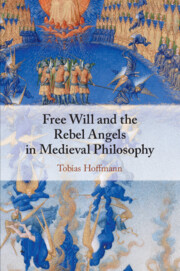Book contents
- Free Will and the Rebel Angels in Medieval Philosophy
- Free Will and the Rebel Angels in Medieval Philosophy
- Copyright page
- Dedication
- Contents
- Acknowledgments
- Abbreviations
- Citation Method
- Introduction
- Part I Free Will
- Chapter 1 Free Will with and without Aristotle
- Chapter 2 The Psychological Turn and the Rise of Intellectualism
- Chapter 3 Voluntarism and the Condemnation of Intellectualism
- Chapter 4 Intermediary Theories and Strict Intellectualism
- Chapter 5 Refinements and Radicalizations
- Part II Whence Evil?
- Part III Angelic Sin
- Bibliography
- Index of Manuscripts
- Index
Chapter 1 - Free Will with and without Aristotle
from Part I - Free Will
Published online by Cambridge University Press: 26 November 2020
- Free Will and the Rebel Angels in Medieval Philosophy
- Free Will and the Rebel Angels in Medieval Philosophy
- Copyright page
- Dedication
- Contents
- Acknowledgments
- Abbreviations
- Citation Method
- Introduction
- Part I Free Will
- Chapter 1 Free Will with and without Aristotle
- Chapter 2 The Psychological Turn and the Rise of Intellectualism
- Chapter 3 Voluntarism and the Condemnation of Intellectualism
- Chapter 4 Intermediary Theories and Strict Intellectualism
- Chapter 5 Refinements and Radicalizations
- Part II Whence Evil?
- Part III Angelic Sin
- Bibliography
- Index of Manuscripts
- Index
Summary
Chapters 1–5 constitute Part I of the book, entitled “Free Will,” about the principal theories of free will from the 1220s–1320s and their background in Aristotle and earlier medieval thinkers. Chapter 1 gives an overview of the accounts of free will by Anselm of Canterbury, Bernard of Clairvaux, and Peter Lombard. Then it sketches the history of the reception of Aristotle’s action theory and offers an account of the principal Aristotelian doctrines that are relevant to later medieval theories of free will.
- Type
- Chapter
- Information
- Free Will and the Rebel Angels in Medieval Philosophy , pp. 13 - 30Publisher: Cambridge University PressPrint publication year: 2020

